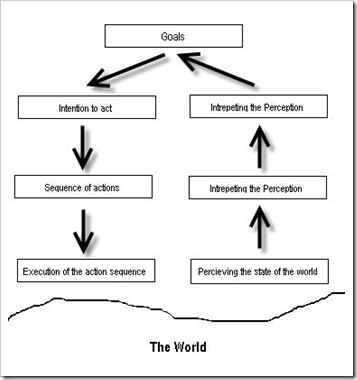
Since I have been reading about User Interface design lately I found many recommendations for Donald Norman's book "The design of Everyday Things". Dr Norman is a psychologist and writes from this perspective focusing on why we react to design. In fact the book was originally titled "The Psychology of Everyday Things". It does not discuss interaction with computers specifically but discusses user interface in a more general sense. Dr. Norman uses many examples that everyone will find familiar, let’s face it we have all been frustrated by poorly designed stuff in our world.
 The first two chapters describe the psychology of every day things and how we interact with thems. There is some very interesting discussion on why common things are sometimes hard to use. He ultimately breaks every action down into seven distinct steps. Good design takes all of these steps into account making achieving goals much easier. One of his most interesting points in this chapter is that humans blame the wrong cause. When a device doesn't work as we expected we tend to blame ourselves instead of the design of the device itself. This is usually because of poor mapping meaning that the way the object works is not what we expect based on our perceptions.
The first two chapters describe the psychology of every day things and how we interact with thems. There is some very interesting discussion on why common things are sometimes hard to use. He ultimately breaks every action down into seven distinct steps. Good design takes all of these steps into account making achieving goals much easier. One of his most interesting points in this chapter is that humans blame the wrong cause. When a device doesn't work as we expected we tend to blame ourselves instead of the design of the device itself. This is usually because of poor mapping meaning that the way the object works is not what we expect based on our perceptions.
The next two chapters discuss how we learn about our environment and how we know what we know. The discussion of memory is very interesting. Particularly the theory that similar events are stacked together was very interesting. Dr. Norman described this as a multiple exposure on a frame of film. In other words similar events get mashed together creating a fuzzy recollection of the common event. Details will not be easy to remember but the general impression of the event(s) can be used to relate to new events. To see what this looks like try the multi-exposure collage on Picassa.
Chapter 5 "To Err is Human" details several types of errors we make. I think the key message in this chapter is that designers must assume users will make mistakes and make them easy to correct. For example; In the section on errors the discussion of Mode Errors, errors which occur when the user is in the wrong mode, struck me due to a recent experience. With today's technology it is very simple to make a switch or button perform many tasks. I recently tried to log into Amazon.com and it kept rejecting my password. After several unsuccessful attempts I finally noticed that the caps lock was on. Windows added a simple error message on their login screen which displays if the caps lock is engaged. A very simple solution for a common problem. Does your application require a login? Perhaps you could add a quick check to see if the caps lock is engaged, I know I will from now on.
Chapter 6 describes the challenges to good design are discussed in depth. The most applicable design pitfall discussed is the fact that "Designers are not Users". Essentially the people who design products, especially software, are not typical of the people who will actually use the product. This is where usability testing and feedback is critical for designers and programmers. He also discusses what he calls "Creeping Featureism" what I would call "feature creep". This falls into the "just because we can do it doesn't mean we should" category. Adding a feature adds to the complexity geometrically making the program much more difficult to use so try to add features that are useful and necessary.
The final chapter gives many ideas for overcoming these inherent design problems. Dr. Norman gives a list of seven principals for making difficult tasks simple
- Use both knowledge in the world and knowledge in the head
- Simplify the structure of tasks.
- Make things visible: bridge the gulfs of Execution and Evaluation.
- Get the mappings right.
- Exploit the power of constraints, both natural and artificial.
- Design for error.
- When all else fails, standardize.
The bottom line is this book covers design from a very scientific view. The principals discussed in the book can be applied to almost anything we use. The science is well presented and the examples emphasize his concepts very well. If your looking for a book to give examples of designing a user interface this isn't it. However, it gives a good baseline view into how people interact with things which gives you an advantage when working on your own designs.



1 comment:
Learning the basic design principles in this book has altered the way I look at everything around me. I recommend it for everyone.
Post a Comment